Emotion detection from speech using Bi-directional LSTM networks and attention mechanism in Keras
How to exploit attention mechanism in LSTM networks for realizing a sentiment analysis application that can distinguish among seven different emotional states: anger, boredom, disgust, fear, happiness, sadness and neutral
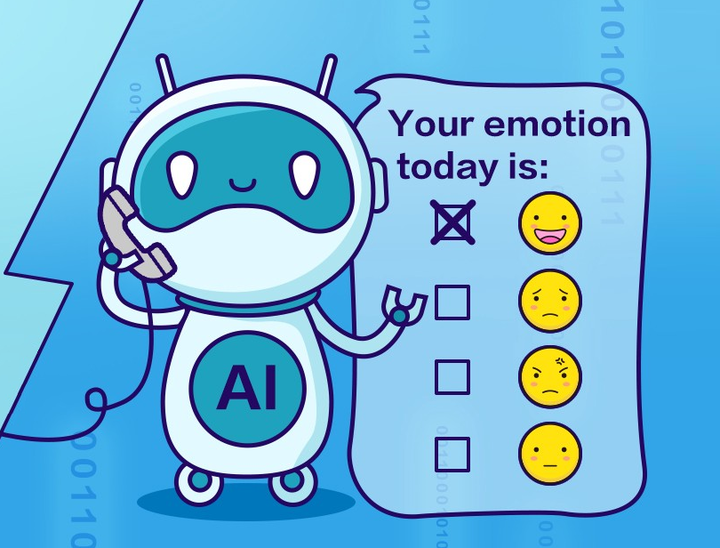
This post is dedicated to the development of an artificial intelligence application capable of identifying the emotions expressed through the voice in spoken language. The classification system focuses on seven different emotions (anger, boredom, disgust, fear, happiness, sadness, neutral) and exploits an attention-based Long Short-Term Memory (LSTM) neural network, a state-of-art deep learning model for the analysis of sequential data, widely used in the field of Natural Language Processing (NLP).
Long Short-Term Memory Networks
The main idea behind this kind of deep learning model is simple but powerful and is inspired by the way reasoning occurs in the human brain. In particular, humans don’t start thinking from scratch every time, but they use memory in order to interpret better a given information, contextualizing it based on past information.
This kind of persistency, which is absent in traditional feed-forward neural networks, is realized by Recurrent Neural Networks (RNN).
These networks are able to use past information thanks to their loop structure, which can be better represented by unrolling the network through time.
 Persistency of information is achieved passing the current hidden state to the next step of the sequence. So, at each time step, the hidden state carries information about what the neural network has seen so far, acting like a memory element.
At the time
Persistency of information is achieved passing the current hidden state to the next step of the sequence. So, at each time step, the hidden state carries information about what the neural network has seen so far, acting like a memory element.
At the time 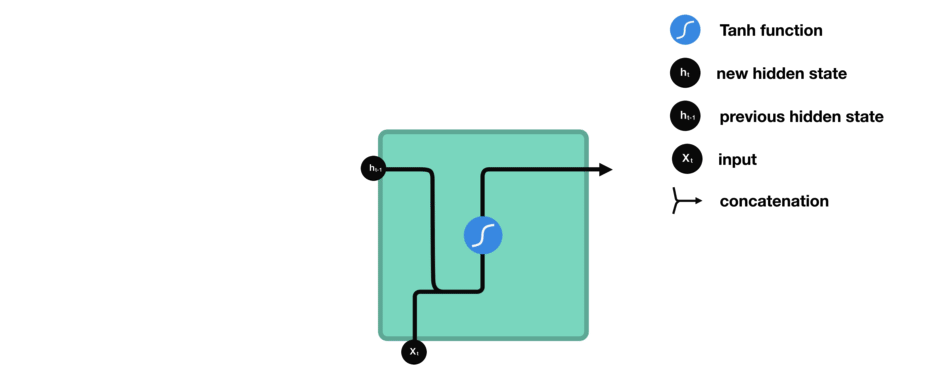
The problem of this kind of networks is that information cannot be carried effectively if the time sequence is too long, which means that we could lose important connections if the distance between useful information and the instant in which it is needed is very large.
For dealing with long short-term dependencies, Long Short-Term Memory networks (LSTM) have been proposed, whose architecture is shown below.
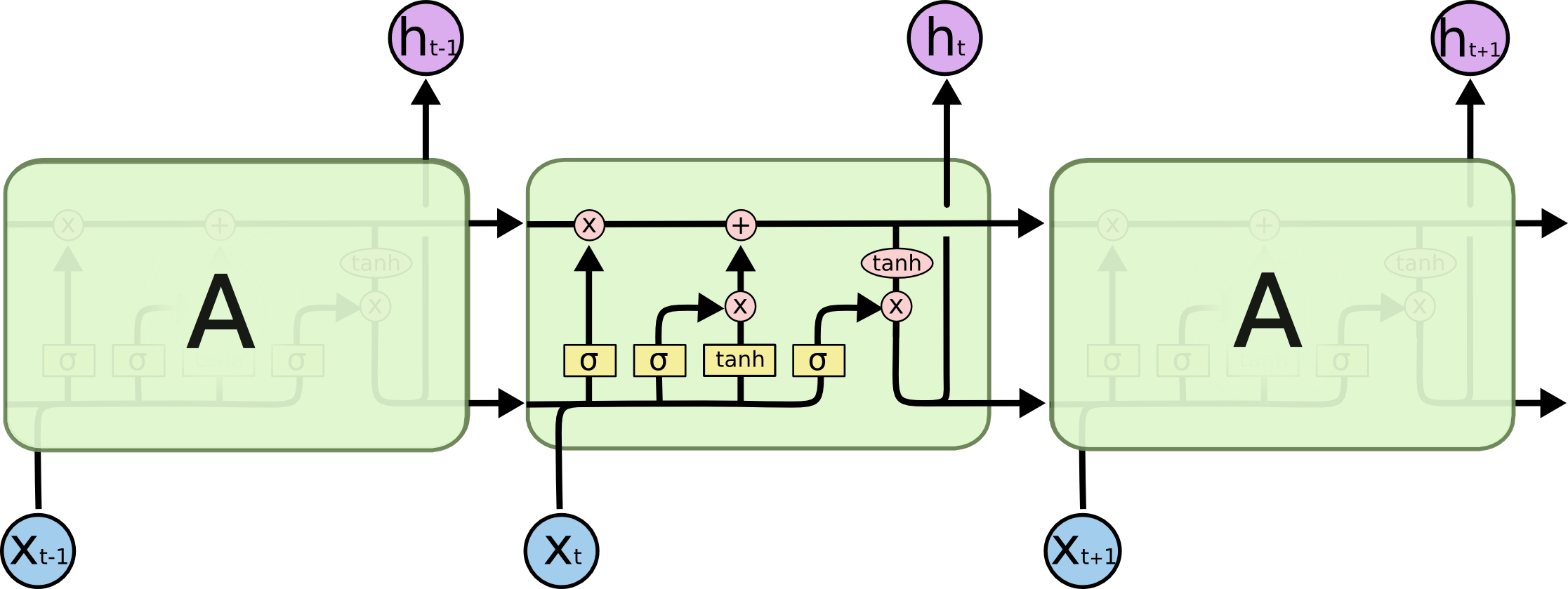 The key element in LSTM networks is the cell state, which acts like memory element, undergoing only a few transformations along the entire chain. In particular, the flow of information is regulated by three structures called gates.
The key element in LSTM networks is the cell state, which acts like memory element, undergoing only a few transformations along the entire chain. In particular, the flow of information is regulated by three structures called gates.
- Forget gate: determines to what extent the components of the cell state must be maintained, by calculating a score using the sigmoid function.
- Input gate: determines what new information to store in the cell state. In particular, a sigmoid layer chooses which state values should be updated, while a tanh layer determines the new candidate values.
- Output gate: determines the final output of the module as a filtered version of the updated cell state:
Emotion detection
Let’s now move on how to use LSTM Neural Networks in Keras, in order to build our emotion detection application. Our dataset is the Berlin Dataset of Emotional Speech (EMO-DB). For its construction 10 actors have been used, who were asked to read 10 portions of different text, simulating seven different emotions: anger, boredom, disgust, anxiety, fear, happiness, sadness and a neutral version, which does not belong to any emotional state. The recordings were made at a frequency of 48kHz, subsampled to 16kHz, inside anechoic chambers provided by the Department of Technical Acoustics of Berlin University, which are designed to minimize the distorting effect of noise. Classifying these recordings according to the expressed emotion is a quite challenging task, as the input data must be represented in an effective way and the patterns to be learned are quite complex.
Feature extraction
Features have been extracted from wav format audio files by exploiting Librosa, a Python package for music and audio analysis. In particular, I used the following
- Spectral centroid: indicates where the centre of mass for a sound is located and is calculated as the weighted mean of the sound frequencies.
- Spectral contrast: estimates the energy contrast by comparing the peak energy to the valley energy.
- Spectral bandwidth: is the wavelength interval in which a spectral quantity is not less than half its maximum value.
- Spectral rolloff: represents the frequency below which a specified percentage of the total spectral energy lies.
- Zero crossing rate: is the rate at which the signal changes from positive to negative or back.
- Root Mean Square: describes the average signal amplitude.
- Mel frequency cepstral coefficients (MFCCs): a small set of features (20 coefficients) which model the characteristics of the human voice, concisely describing the overall shape of the spectral envelope.
- MFCC’s first order derivatives: 20 coefficients which capture the ways in which the MFCCs of the audio signal vary over time.
I used a frame length
Class balancing
The dataset is composed by 535 audio files, whose emotion distribution is shown below.
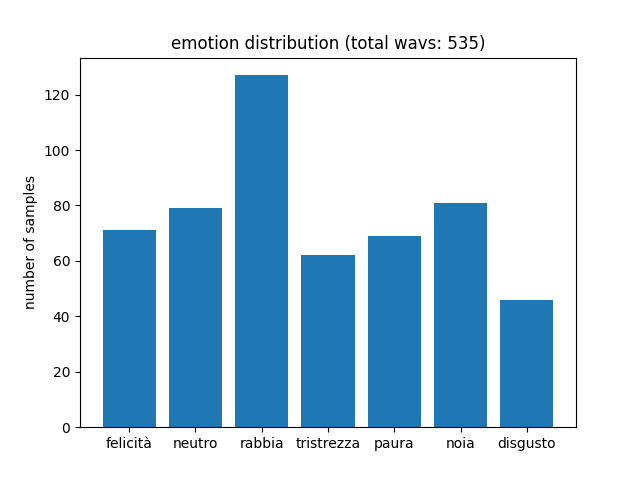 As we can see, training samples are quite unbalanced, which can cause problems in recognizing less represented emotions, such as disgust or sadness.
To cope with this issue, I used a class balancing strategy called Synthetic Minority Over-sampling Technique (SMOTE). It is an oversampling technique, which consists in increasing the number of samples relating to the less represented classes.
In particular, new synthetic examples are created through interpolation techniques in order to obtain the same number of samples per class. After class balancing, the dataset contains 749 examples, from which 20 non-synthetic samples per class are selected as our test set.
It is crucial here to select non-synthetic test samples for measuring fairly the performance of our classification model.
As we can see, training samples are quite unbalanced, which can cause problems in recognizing less represented emotions, such as disgust or sadness.
To cope with this issue, I used a class balancing strategy called Synthetic Minority Over-sampling Technique (SMOTE). It is an oversampling technique, which consists in increasing the number of samples relating to the less represented classes.
In particular, new synthetic examples are created through interpolation techniques in order to obtain the same number of samples per class. After class balancing, the dataset contains 749 examples, from which 20 non-synthetic samples per class are selected as our test set.
It is crucial here to select non-synthetic test samples for measuring fairly the performance of our classification model.
Attention mechanism for emotion detection
The use of attention mechanism in neural networks have demonstrated great success in a wide range of tasks, such as question answering, machine translations, natural language understanding and speech recognition. The main idea behind the attention mechanism, which mimics human behaviour, is to selectively concentrate on a few relevant things, while ignoring the rest. There are many variations of this mechanism (global vs. local, soft vs. hard) but its main use, for enhancing LSTM models such as encoder-decoder structures (e.g. in machine translation), is to avoid the use of a fixed context vector as the only output of the encoder. Specifically, it is the last hidden state of the LSTM, which carries all the information extracted by the LSTM encoder. So, in the classical structure, all the information is compressed into the context vector, which can act as a bottleneck, while all the intermediate hidden states of the encoder are ignored. This vector is then fed to the subsequent layers, such as LSTM decoder or Dense. As for the subsequent steps we only depend on this kind of summarization given by the encoder, the performances can degrade as the length of the analyzed temporal sequence increases: to cope with this problem, attention mechanism is the way!
In general, according to this mechanism, every encoder hidden state, generated while processing the input sequence, is taken into account, calculating for each one of them an attention score (energy
- Additive or concat (Bahdanau):
- Dot-product (Luong):
- Other types of attention are location-based, general and content-based.
For our emotion detection model I used a Bahdanau-style global soft attention. In particular, I adapted the formula to this classification task, where the decoder is absent. The alignment model is, like in Bahdanau, a parametrized feedforward neural network and the energies are computed as
In the following, I show the Keras implementation of the proposed model (Attention_BLSTM). In order to assess the benefits brought by the attention mechanism, a simplified version of the model without attention (BLSTM) is also provided.
def create_model(units=256):
input = keras.Input(shape=(pre_proc.N_FRAMES, pre_proc.N_FEATURES))
if MODEL == "Attention_BLSTM":
states, forward_h, _, backward_h, _ = layers.Bidirectional(
layers.LSTM(units, return_sequences=True, return_state=True)
)(input)
last_state = layers.Concatenate()([forward_h, backward_h])
hidden = layers.Dense(units, activation="tanh", use_bias=False,
kernel_initializer=keras.initializers.RandomNormal(mean=0., stddev=1.)
)(states)
out = layers.Dense(1, activation='linear', use_bias=False,
kernel_initializer=keras.initializers.RandomNormal(mean=0., stddev=1.)
)(hidden)
flat = layers.Flatten()(out)
energy = layers.Lambda(lambda x:x/np.sqrt(units))(flat)
normalize = layers.Softmax()
normalize._init_set_name("alpha") ###for visualizing attention, more on this later...
alpha = normalize(energy)
ctx = layers.Dot(axes=1)([states, alpha])
context_vector = layers.Concatenate()([ctx, last_state])
elif MODEL == "BLSTM":
context_vector = layers.Bidirectional(layers.LSTM(units, return_sequences=False))(input)
else:
raise Exception("Unknown model architecture!")
pred = layers.Dense(pre_proc.N_EMOTIONS, activation="softmax")(context_vector)
model = keras.Model(inputs=[input], outputs=[pred])
model._init_set_name(MODEL)
print(str(model.summary()))
return model
Results
I evaluated the trained models using 20 test samples per emotion. The attention-based BLSTM achieved a 90% accuracy, while its simplified version which does not use attention achieved about 75% accuracy.
| Accuracy | Precision | Recall | F1-Score | |
|---|---|---|---|---|
| BLSTM | 0.75 | 0.75 | 0.75 | 0.74 |
| Attention-based BLSTM | 0.90 | 0.91 | 0.90 | 0.90 |
As we can easily see, the use of the attention mechanism has led to much higher performances than a classical BSLTM. To better see the performance improvement in recognizing the different emotions, confusion matrices for both models are provided:
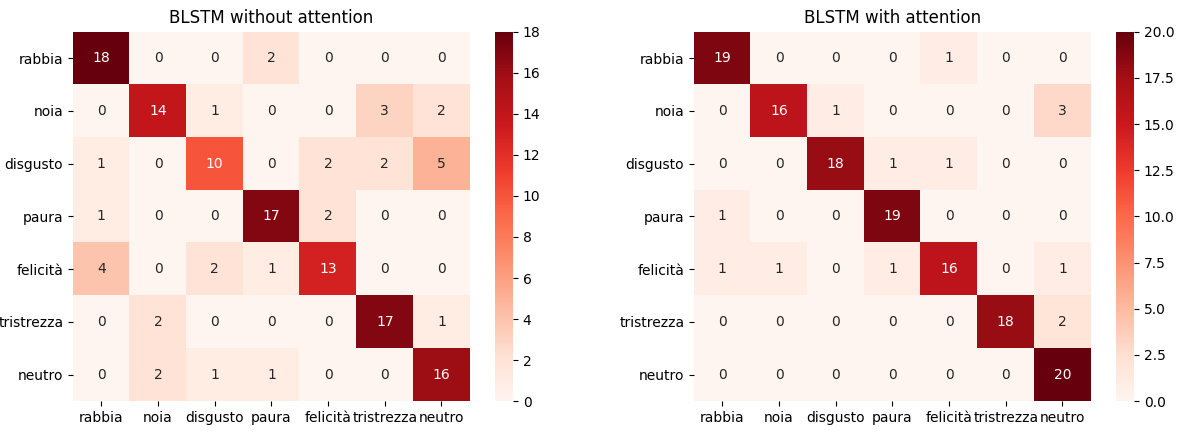 We can clearly see a good improvement in recognizing every emotion, most of all for what concerns disgust, happiness and neutral classes.
We can clearly see a good improvement in recognizing every emotion, most of all for what concerns disgust, happiness and neutral classes.
Just to make it more fun, giving you some more concrete examples of the system behaviour, we can choose a test file for each emotion and take a look at what the system thinks about it. (Click 🔈 to play the audio!)
- Anger 🔈 — detected emotion: anger (0.96 confidence)
- Boredom 🔈 — detected emotion: boredom (0.89 confidence)
- Disgust 🔈 — detected emotion: disgust (0.94 confidence)
- Fear 🔈 — detected emotion: fear (0.96 confidence)
- Happiness 🔈 — detected emotion: happiness (0.88 confidence)
- Sadness 🔈 — detected emotion: sadness (0.98 confidence)
- Neutral 🔈 — detected emotion: neutral (0.90 confidence)
It’s pretty cool! The model correctly classified all of the selected audio files with a high level of confidence 👏👏
Visualizing attention 👀
Lastly, an interesting thing we can do is to take a close look at the attention weights 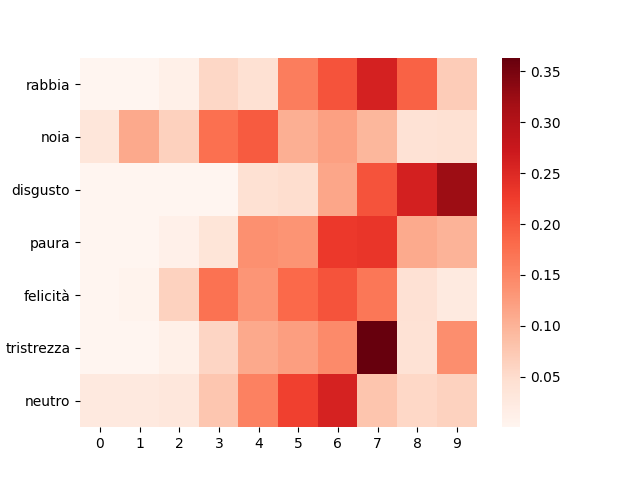 The plot shows the normalized cumulative sum of the attention weights, dividing the audio files into 10 blocks (bins) of 0.5 seconds each. As we can see, according to the different expressed emotion,
the system focuses on different parts of the audio. For example, it concentrates most on a small group of bins for sadness and disgust, while diluting the attention on a larger part of the audio, for boredom or happiness.
Furthermore, for anger, disgust and sadness the system pays more attention to the last bins, while for boredom it focuses on the first ones.
The plot shows the normalized cumulative sum of the attention weights, dividing the audio files into 10 blocks (bins) of 0.5 seconds each. As we can see, according to the different expressed emotion,
the system focuses on different parts of the audio. For example, it concentrates most on a small group of bins for sadness and disgust, while diluting the attention on a larger part of the audio, for boredom or happiness.
Furthermore, for anger, disgust and sadness the system pays more attention to the last bins, while for boredom it focuses on the first ones.
You can find the full code on GitHub at this link.